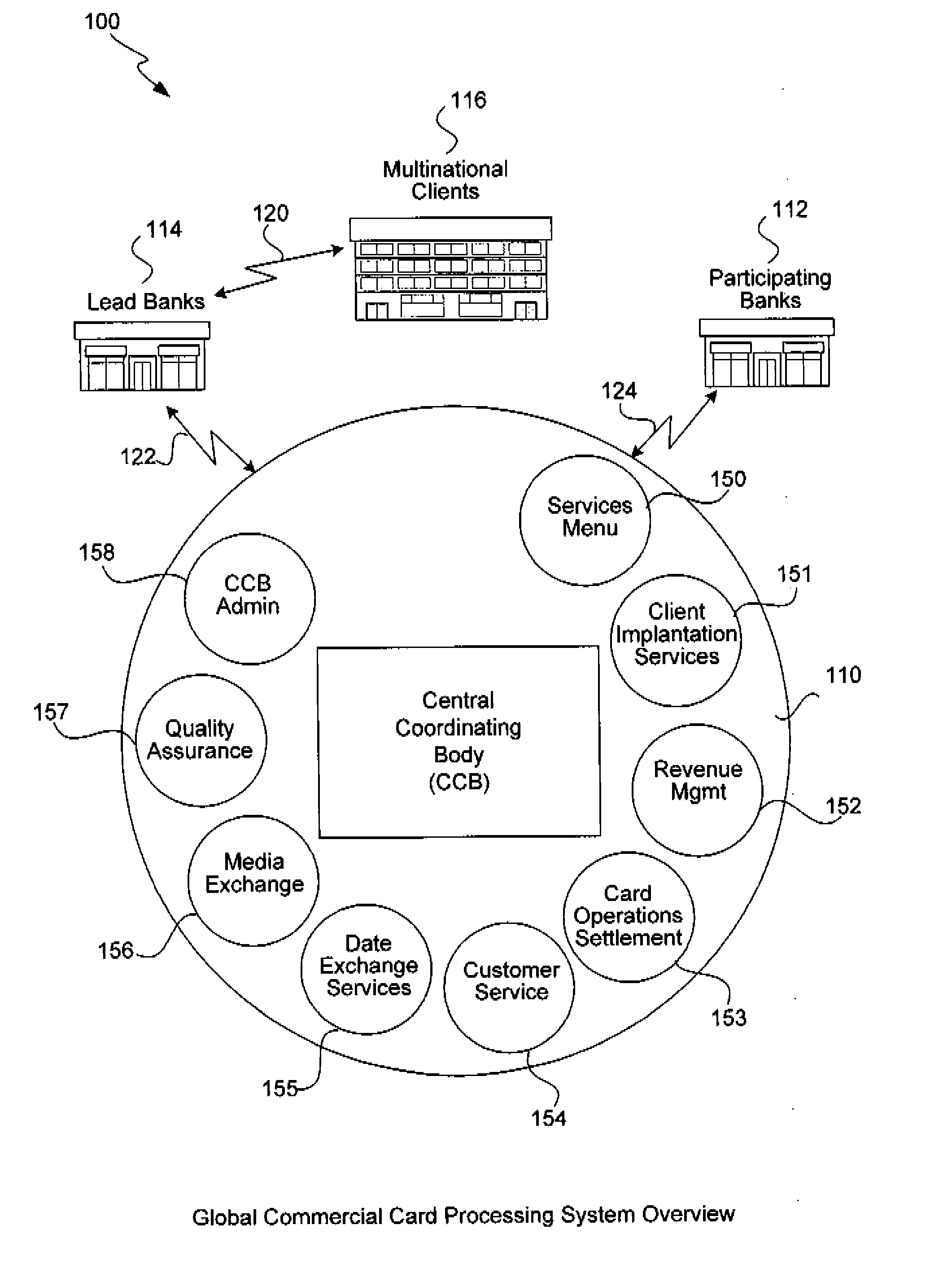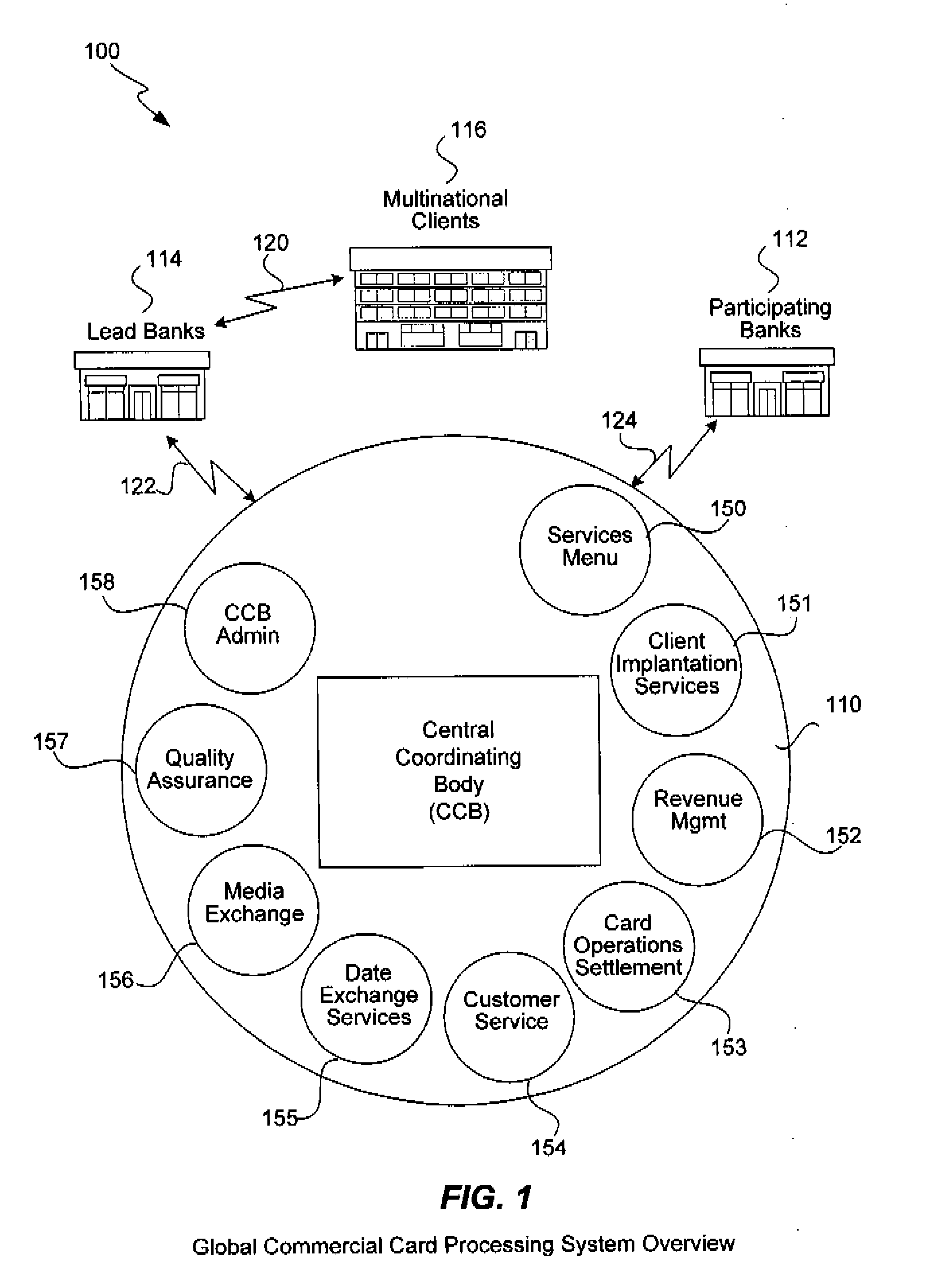For a financial institution (e.g., a bank or similar organization) that is not part of a unified global company it can be difficult to bid on this card business for a multi-national corporation or a governmental agency.
Unfortunately for these card issuers, multi-national corporations are requiring that a corporate or purchasing card be issued to their employees in many different countries.
When such a multi-national corporation releases a request for proposal (RFP) to implement a corporate or purchasing card program, a local U.S. card issuer often cannot respond to such an RFP because they would be unable to supply the required services in all the different countries required.
Even though the local U.S. card issuer would be more than happy to implement the U.S. portion of such a program for IBM and support only the domestic business, it may be unable to submit a competitive bid, as it cannot support the international portion and offer a global business solution to the multi-national corporation.
In other words, a local card issuer often cannot meaningfully provide the global services required by a multi-national corporation and, as a result, it may lose out on receiving the domestic business as well.
Another difficulty in responding to an RFP from a multi-national corporation is that the corporation may expect a response (including proposed agreements) within a short time frame, often within two to three weeks of issuance of the RFP.
A local card issuer that does not have a global presence or an ability to line up a counterpart bank in a different country would find it extremely difficult to respond to such a request within the required time frame.
In addition to a local card issuer finding it difficult to bid on a global card program, there are other difficulties.
For example, multi-national corporate credit or charge card accounts are far more complex then a regular consumer credit or charge card account because of the variety of agreements that need to be signed.
In addition, assessing credit risk of the individual cardholder and / or company subsidiary in foreign countries can be challenging.
Another major difference between consumer and corporate cards is the amount and quality of data that must be collected for each transaction due to requirements imposed by the corporations.
Such requirements can complicate the ability of a local card issuer to service and provide a global card program.
A card issuer with only a local presence and even one with limited global presence will find it much more difficult to meet these requests that often span many countries.
In sum, local card issuers often find it difficult to win the global business of multi-national corporations because the accounts are much more complex, require more intensive data gathering, and the local card issuer often has no global presence or servicing capabilities.
This leads to difficulties in preparing a bid document, difficulties in understanding the bank's local capabilities, uncertainties in assuring a consistent level of customer service, etc.
These agreements, however, are by no means standardized, and typically can be quite cumbersome and time consuming to arrange.
The data and servicing arrangements provided to the employees of the corporate client from these arrangements may also not be uniform or consistent.
Moreover, enforcing consistency up to the levels expected by the multinational client is often problematic.
While such arrangements can occur between banks of two different countries, agreements between three or more banks in different countries are much less common and obviously much more complex to successfully arrange and negotiate.
In summary, the problems with prior techniques are quite daunting, and include such issues as: a local bank may lack territorial coverage; a bank may not know its capabilities or those of its potential partner banks; the local bank may not be able to assemble a bid quickly and put multiple agreements between different partners in place within the time required to meet the demands of a potential client; the bank may not be able to guarantee a consistent standard of customer service; lack of standard card features; and the bank faces inconsistent and poorly organized data gathering techniques and systems for international card programs.
Unless the card issuer has a global reach, it is difficult to gather all local country data, standardize it, aggregate it and produce a consolidated global MIS report for the multinational client.
If, for example, a multinational client has employees in twenty-five different countries, it is not efficient nor convenient to have to deal with twenty-five different card managers (or more) regarding problems with the card program in these countries.
Third, clients also wish to have a global price or contract which takes into account any fees that are assessed, rebates granted or other. For example, if a client does not wish to pay annual card fees on a global basis, it can be a problem for an issuing bank in a single country in which a small number of cards are issued insists upon annual card fees. To satisfy the multinational client's desires, the card issuing bank would like to be able to promise to the client that no card fees will be assessed anywhere in the world. However, there may still be the need for the card issuing bank to accommodate the local card issuing bank in the other countries that insist on assessing card fees. Regarding rebates, a multi-national client with a large volume of charges on their cards will expect rebates from these charges, often on a seller by seller basis. A client may insist that the formula for calculating the rebate amount be negotiated globally and may require that the volumes going through particular sellers be applied worldwide. A single global price that includes any card fees and takes into account rebates is appealing to a corporation.
Fourth, a multinational client requires that customer service be available locally and of significant quality. As an example, a German company may require that a German branded card be issued to its employees, and that customer service for its German employees be provided locally, with German speaking customer service representatives, that statements be written in German, and that all transactions be denominated in local currency. Further, the local customer service center must be familiar with all local laws, regulations and customs. In addition, for transactions that take place within Germany, the merchant will likely wish to be paid in Deutsche marks or Euros, the multinational employee cardholder wishes to have their statement denominated in Deutsche marks and the client company wishes to pay their expenses in Deutsche marks. Local service also means handling all questions, increasing credit or spending limits, handling lost and stolen cards, handling fraud issues, etc. This need for local servicing applies to countries where the multinational has many thousands of employees and even for countries where that may be only a handful of employees who will be issued cards. The inability of a bank to provide such local servicing even in the market where a few cards are required may mean that the bank will not win the global business from the multinational client.
Certainly there are potential solutions to the above difficulties but they are often not optimal.
This arrangement can be problematic because the local bank in a given country will normally find it very difficult to service and provide all of the processing required in all locales, including the multiple currencies and languages required for servicing the accounts on a local basis in all countries.
This arrangement does not provide the local presence that is required.
In addition, because the card issuing institution is not considered local in the overseas markets, transactions in those countries may incur foreign currency conversion fees.
Moreover because of the distances involved between processing centers and residences of cardholders, statements and cardholder payments may take longer in transit between recipients, resulting in possible late fees.
In addition, moving funds internationally to make payments on accounts can be costly and time consuming.
Although theoretically possible, it can prove difficult to find a processor that will process in enough foreign countries.
For these reasons, for a local bank to issue its cards in all foreign countries is not especially desirable or workable as a solution.
Other approaches are possible but are also not ideal.
Although this arrangement is feasible, it still suffers from the drawbacks mentioned above.
Furthermore, there may not be adequate communication between the banks, or the banks may not have implemented standard data formats or desire to undertake the expense of doing so for a small amount of business on an ad hoc basis—this would mean an issuer may not be able to provide a standard data format for a client that desires a global management information systems approach.
Most importantly, the lead bank may not know the capabilities of the foreign banks, or even if apprised of these capabilities, it may not be able to guarantee a particular type of product or level of service to the client.
Each individual bank in each country would be able to provide local servicing, but overall this approach does not meet many of the needs of clients addressed above.
Thus, while a card issuer in a given country may have relationships with card issuers in other countries, its ability to compete for multi-national corporate and government clients is severely limited by lack of a well-defined process for assembling bids, pricing bids, managing customer service, as well as the lack of a comprehensive global processing and servicing capability.
 Login to View More
Login to View More  Login to View More
Login to View More 


